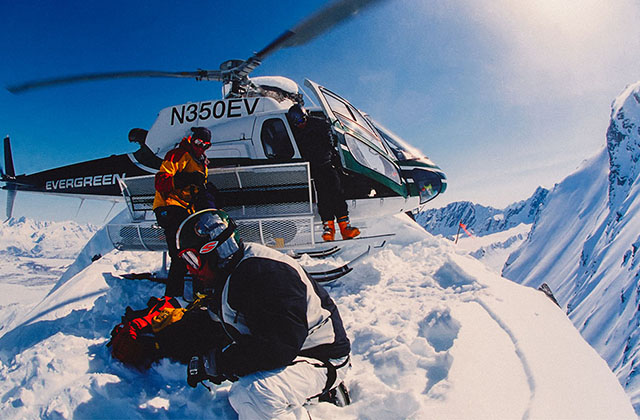One of the most serious threats to backcountry or heli skiers and snowboarders are avalanches. But, the fact that nearly all avalanches which endanger people are triggered by the skiers or boarders themselves means that in most cases, they are preventable. A commonly reported statistic is that 95% of all heli skiing Canada in the world occurs in British Columbia.
An avalanche doesn’t recognise whether or not you are an expert. But, if you are well-informed or otherwise aware, you can minimise your exposure to risk and the chances of ending up as a statistic. A combination of experience, education and awareness of continuingly changing environmental factors will enable you to balance good backcountry or heli skiing with a high degree of safety.
There are three critical factors that contribute to the potential for avalanche – terrain, snowpack and weather.
Understanding these factors and how they interact to cause avalanches can save your life:
1. Terrain
Most fatal avalanches occur on slopes of 35 to 45 degrees – the ones we most like to ski and snowboard! Those less steep, seldom produce avalanches, and those of 50 degrees or more are generally too steep to allow for a critical amount of snow to accumulate.
So be careful of slopes that are similar in steepness to a red run or steeper. And remember that all the snow on the slope you’re on is connected so you can trigger a slide above you if the snowpack is sufficiently unstable.
Avoid being in positions where there is no escape if an avalanche does start and avoid exposure to ‘terrain traps’ – features that will compound the effects if an avalanche occurs. These might include depressions or river beds, cliffs or rocks.
2. Understand snowpack stability
To play safely in the backcountry, whether heli skiing or ski touring, being able to recognise unstable snow and avoid it will keep you out of trouble. The properties of the snowpack are, to a large degree, affected by precipitation, temperature and wind. Layers of snow build up and change continuously throughout the winter – some are strongly bonded and some are not.
While strong layers usually consist of small, round snow grains, densely packed and well bonded, weak layers tend to be comprised of poorly bonded crystals with little cohesion. Weak layers often appear loose or ‘sugary’.
Weak layers prevent stable bonding between strong snow and therefore affect the overall stability of the snowpack. In times of high stability, the strength of the bonding between layers is greater than the stress exerted on them. As the stress level approaches the strength level, the snowpack becomes increasingly unstable.
Stress increases can be the result of a rapid precipitation load, a sudden increase in temperature, wind-blown snow or human pressure.
Anchors such as trees and rocks protruding through the snowpack can help stabilize it but clumps of trees need to be thick to be effective; often too dense for skiing. What’s more, fracture points can occur at stress concentrators such as trees and rocks.
3. Observe the weather & understand how it affects stability
There are four major weather factors that contribute to avalanches – precipitation, wind, temperature and solar radiation.
The more rapidly precipitation falls, the less time the snowpack has to adjust to the additional stress, leading to a greater danger of avalanche. Of course, the type of precipitation and the quantity can also have an impact.
Take note of wind speed and direction when you’re out. Wind can rapidly redistribute snow and load leeward slopes with ‘slabs’ of snow which are poorly bonded to existing layers. Cornices (large overhanging slabs of snow) give a good indication of the prevailing wind direction and therefore, which slopes might be loaded.
Both warmer and colder conditions can lead to instability. In general, a warmer snowpack will settle more quickly, compacting to become denser and stronger than a cold snowpack. But if warming is intense and persistent, the snowpack can become wet and very unstable. Be particularly wary if temperatures are not dropping below freezing at night.
The combination of cold temperatures and a shallow snowpack leads to a process called faceting which can result in the formation of extremely unstable layers. With little change in temperature these layers can persist for long periods of time. So, beware when heli skiing on shady northern aspects especially early on in the season when it is cold and relatively little snow has accumulated.
Later on, in spring, when the sun can trigger wet avalanches, south-facing slopes can be more hazardous.
Other ways to reduce risk
If you are heading into the backcountry either under your own steam or by helicopter, take an experienced guide with local knowledge – the best heli skiing guides are UIAGM certified meaning that they have undergone years of training and passed a series of comprehensive exams. Inform people of your anticipated route and timings and listen to local advice and avalanche warnings.
You should only heli ski with reputable companies that employ certified guides and follow accepted safety procedures. But remember that just because you are with a guide or heli ski operator, you are not immune from the avalanche danger, and you should always bear in mind the factors in this article.
James Morland has a background in snow safety and now is Managing Director of Elemental Adventure Heli Skiing, a leading specialist offering tours to Canada, Alaska, Himalayas, Russia, Turkey, Greenland and other worldwide destinations. They’ve done it all before and have extensive first hand experience, which means they can ensure that the biggest ski trip of your life is also the best ski trip of your life.
Article Source: http://EzineArticles.com/expert/James_Morland/52121
Article Source: http://EzineArticles.com/297003



